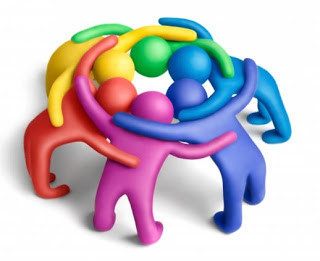A team is only as successful as the cohesion it has between its members. Enough cohesion and the team will stick together through the toughest of times. Too little and it will fragment when things don’t go according to plan. But what does a cohesive team look like? What are the ingredients for building cohesion in teams and what do leaders need to focus on to make sure the team members want to deliver mission after mission? Here’s our take on it:
1.Vision with dialogue
Leaders, teams and vision are talked about often. Experience has shown me that leaders with vision are important, but clear communication about the vision that bring it to life for the team, by the team, are the only way that vision can become a reality. The dialogue about the vision needs to have three things: clarity, connection and constant dialogue. And I don’t mean chant it daily, although do that if it works for you! What I mean is relate everyday activity to it, all the time. Strong leaders do this without using the word ‘vision’. If you can’t connect activity to the long term, then question why it’s being done at all and don’t expect your team to be able to connect it for themselves. And when something is happening that will detract from the vision, be clear about what it is and what’s needed and if you need to, re-think the vision itself. Whatever you do, don’t leave it open to unchecked interpretation.
2. Ownership with enquiry
We work on the principle that we’re all adults at work. It means we each ‘own’ our contribution in terms of what we bring and how we bring it to the team. If there is ownership, the leader’s role is a smoother one. Conversely, a lack of ownership, even in just one team member, can divert the whole team’s focus as they become distracted in the unhelpful behaviour. Strong leaders have clear strategies for creating ownership, maintaining it and role modelling it. But what does ownership really look like? For me, it’s when things don’t go according to plan that ownership (or a lack of it) shows up most. Let’s look at an example. Person A mishandles a discussion in a meeting. They’re defensive when challenged about an idea they’ve been working on. If ownership is an intrinsic part of the team’s culture, they feel safe enough to say something like “I was off kilter today and I didn’t handle that meeting/conversation well. I’m sorry. Let me digest where we are and look at how we can move forward from here?”. The other half of the ownership balance is in the response. If ownership is present, there are few (if any) side conversations, no biting sarcasm and no gossip. The leader won’t dismiss the apology or give responses like ‘not to worry about it’. Other team members may enquire, privately with Person A along the lines of “are you ok, what was that about? What happened?” and offer support. They’ll accept and build upon the apology that has been offered. It’s uncomfortable, it happened, now what? Person A retains the responsibility to handle how they behave when they feel ‘off kilter’ in the future and work out what solutions will work for their personality and circumstances. Support has been offered for them to make use of if they feel they need it. It’s dealt with, honestly and transparently, with next steps agreed to learn from it and move past it. But what creates and sustains ownership?
3. Courage with care
I’ve seen courage confused with confidence, positive talk and/or risk taking. All these are important too in the right measure, but for me, courage is essential in team work and it’s about strength of character, empathy and personal investment to the team vision and purpose. It’s easy to celebrate a good result or go the extra mile in a silo, but it takes courage to speak up or provide an opposing view when something isn’t working and/or hold a difficult silence against a popular view. It’s also about having the courage to hold each other to account when something hasn’t been delivered rather than move into martyr/rescue mode. Then, once the point has been made and heard, let go. So, courage, in this definition, is about finding a way to call out the ‘elephant’ in the room, constructively, without playing a blame game, to the person or people that can make a decision. And then it’s deciding to move on. Here, the leader’s role is to encourage people to do right, not be right, if the team is to really break new ground.
4. Recognition with thought
Early in my career, recognition was put to me as the 4th basic human need after food, shelter and safety. But just as people have different preferences for what they eat, where they live and what makes them feel safe and secure. Recognition too, is personal. So simply saying ‘thanks, good job!’ or having a ‘when you do this, we’ll give you that’ approach won’t work if you’re expecting people to bring their full personal investment, courage and commitment to achieving the team goals.
So, what is the answer? As is often the case with people, the answer is in the dialogue. It’s a question, or series of questions and there’s no catch all answer. The most effective recognition givers tend to gain the best team results and they do this through enquiry, observation and thoughtfulness about the individuals, as well as the collective. And then there’s also the issue of timing. Recognise achievement when there’s something to celebrate. And don’t just focus on the task, focus on what you want someone to do more of. Look for it, find it and recognise it in a way that’s meaningful for the individual. Encourage line managers to do the same and you’ll see team engagement flourish.
And while we’re talking about encouragement, don’t confuse it with support. Everyone, no matter how high their experience and competence levels, can be boosted with some well-timed, on point, encouragement from the right source, to do a great job. They might not need any support. They will always benefit from feeling appreciated. And that’s a huge recognition tool that adds nothing to the overheads in your P&L. Where support is needed, identify it and provide it. Where it isn’t, get out of the way with genuine gestures of faith that they’ll deliver. This shows trust. And there’s no bigger human validation mechanism than feeling trusted and appreciated.
We love working with leaders and their teams so they can identify their culture, build on their working relationships and connect with their goals. If you’d like to discuss how we might help, we’d love to hear from you. Contact us today for a no obligation consultation.

